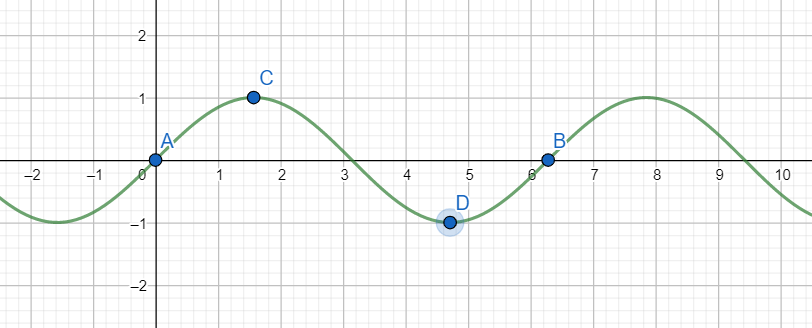Answer
460.5k+ views
Hint: Recall the conditions of Rolle’s theorem. Verify whether those conditions are satisfied. If they are satisfied, recall the guarantee of Rolle's theorem. Check whether the guarantee is true for the above function. Hence verify Rolle’s theorem.
Complete step-by-step answer:
Rolle’s theorem: If f(x) is a function such that:
[1] f(x) is continuous in the interval [a,b]
[2] Derivable in the interval (a,b)
[3] f(a) = f(b)
then there exists c such that aHere $f\left( x \right)={{x}^{2}}+5x+6$
Since f(x) is a polynomial and polynomials are continuous for all real x, we have
f(x) is continuous in [-3,-2].
Also f’(x) = 2x+5 is a polynomial in x and hence is continuous in (-3,-2).
Hence f(x) is differentiable in (-3,-2) [Because if the derivative of a function is continuous in an interval, then the function is differentiable in that interval].
Also f(-3) $={{\left( -3 \right)}^{2}}+5\left( -3 \right)+6=9-15+6=0$ and f(-2) $={{\left( -2 \right)}^{2}}+5\left( -2 \right)+6=4-10+6=0$, we have f(-3) = f(-2) = 0.
Hence all conditions of Rolle’s theorem are satisfied. Hence there exists a real number c such that -3 < c < -2 such that
f’(c)=0.
Now f’(c)=2c+5=0
Hence 2c =-5
i.e. $c=-\dfrac{5}{2}$
i.e. c=-2.5.
Now since
-3 <-2.5< -2.
Hence there exists a c = -2.5 such that -3< c < -2 and f’(c) =0.
Note: [1] Rolle’s theorem guarantees the existence of one such “c”, however, does not say anything about the number of such “c”. Hence there may exist more than one such “c” which satisfy the above conditions as in the following graph.

In the interval [A, B] there exist two points C and D at which the derivative of the above function vanishes.
Complete step-by-step answer:
Rolle’s theorem: If f(x) is a function such that:
[1] f(x) is continuous in the interval [a,b]
[2] Derivable in the interval (a,b)
[3] f(a) = f(b)
then there exists c such that a
Since f(x) is a polynomial and polynomials are continuous for all real x, we have
f(x) is continuous in [-3,-2].
Also f’(x) = 2x+5 is a polynomial in x and hence is continuous in (-3,-2).
Hence f(x) is differentiable in (-3,-2) [Because if the derivative of a function is continuous in an interval, then the function is differentiable in that interval].
Also f(-3) $={{\left( -3 \right)}^{2}}+5\left( -3 \right)+6=9-15+6=0$ and f(-2) $={{\left( -2 \right)}^{2}}+5\left( -2 \right)+6=4-10+6=0$, we have f(-3) = f(-2) = 0.
Hence all conditions of Rolle’s theorem are satisfied. Hence there exists a real number c such that -3 < c < -2 such that
f’(c)=0.
Now f’(c)=2c+5=0
Hence 2c =-5
i.e. $c=-\dfrac{5}{2}$
i.e. c=-2.5.
Now since
-3 <-2.5< -2.
Hence there exists a c = -2.5 such that -3< c < -2 and f’(c) =0.
Note: [1] Rolle’s theorem guarantees the existence of one such “c”, however, does not say anything about the number of such “c”. Hence there may exist more than one such “c” which satisfy the above conditions as in the following graph.

In the interval [A, B] there exist two points C and D at which the derivative of the above function vanishes.
Recently Updated Pages
Mark and label the given geoinformation on the outline class 11 social science CBSE

When people say No pun intended what does that mea class 8 english CBSE

Name the states which share their boundary with Indias class 9 social science CBSE

Give an account of the Northern Plains of India class 9 social science CBSE

Change the following sentences into negative and interrogative class 10 english CBSE

Advantages and disadvantages of science

Trending doubts
Bimbisara was the founder of dynasty A Nanda B Haryanka class 6 social science CBSE

Which are the Top 10 Largest Countries of the World?

Difference between Prokaryotic cell and Eukaryotic class 11 biology CBSE

Differentiate between homogeneous and heterogeneous class 12 chemistry CBSE

10 examples of evaporation in daily life with explanations

Fill the blanks with the suitable prepositions 1 The class 9 english CBSE

Give 10 examples for herbs , shrubs , climbers , creepers

How do you graph the function fx 4x class 9 maths CBSE

Difference Between Plant Cell and Animal Cell



